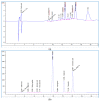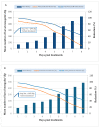Sustainable Pest Management Using Novel Nanoemulsions of Honeysuckle and Patchouli Essential Oils against the West Nile Virus Vector, Culex pipiens, under Laboratory and Field Conditions
- PMID: 37960039
- PMCID: PMC10650709
- DOI: 10.3390/plants12213682
Sustainable Pest Management Using Novel Nanoemulsions of Honeysuckle and Patchouli Essential Oils against the West Nile Virus Vector, Culex pipiens, under Laboratory and Field Conditions
Abstract
Essential oils are natural plant products that are very interesting, as they are important sources of biologically active compounds. They comprise eco-friendly alternatives to mosquito vector management, particularly essential oil nanoemulsion. Therefore, the aim of this study is to evaluate the effectiveness of 16 selected essential oils (1500 ppm) in controlling mosquitoes by investigating their larvicidal effects against the larvae and adults of the West Nile virus vector Culex pipiens L. (Diptera: Culicidae); the best oils were turned into nanoemulsions and evaluated under laboratory and field conditions. The results show that honeysuckle (Lonicera caprifolium) and patchouli (Pogostemon cablin) essential oils were more effective in killing larvae than the other oils (100% mortality) at 24 h post-treatment. The nanoemulsions of honeysuckle (LC50 = 88.30 ppm) and patchouli (LC50 = 93.05 ppm) showed significantly higher larvicidal activity compared with bulk honeysuckle (LC50 = 247.72 ppm) and patchouli (LC50 = 276.29 ppm) oils. L. caprifolium and P. cablin (100% mortality), followed by Narcissus tazetta (97.78%), Rosmarinus officinalis (95.56%), and Lavandula angustifolia (95.55%), were highly effective oils in killing female mosquitoes, and their relative efficacy at LT50 was 5.5, 5.3, 5.8, 4.1, and 3.2 times greater, respectively, than Aloe vera. The results of the field study show that the honeysuckle and patchouli oils and their nanoemulsions reduced densities to 89.4, 86.5, 98.6, and 97.0% at 24 h post-treatment, respectively, with persistence for eight days post-treatment in pools. Nano-honeysuckle (100% mortality) was more effective than honeysuckle oils (98.0%). Our results show that honeysuckle and patchouli oils exhibited promising larvicidal and adulticidal activity of C. pipiens.
Keywords: Culex pipiens; essential oils; honeysuckle; nanoemulsions; patchouli; plants bioactive compounds; polyphenols.
Conflict of interest statement
The authors declare no conflict of interest. The funders had no role in the design of the study; in the collection, analyses, or interpretation of data; in the writing of the manuscript; or in the decision to publish the results.
Figures










Similar articles
-
Larvicidal and adulticidal activity of essential oils from plants of the Lamiaceae family against the West Nile virus vector, Culex pipiens (Diptera: Culicidae).Saudi J Biol Sci. 2022 Aug;29(8):103350. doi: 10.1016/j.sjbs.2022.103350. Epub 2022 Jun 16. Saudi J Biol Sci. 2022. PMID: 35762012 Free PMC article.
-
Nanostructured Lipid Carriers (NLC) for Biologically Active Green Tea and Fennel Natural Oils Delivery: Larvicidal and Adulticidal Activities against Culex pipiens.Molecules. 2022 Mar 17;27(6):1939. doi: 10.3390/molecules27061939. Molecules. 2022. PMID: 35335302 Free PMC article.
-
Honeysuckle essential oil as a potential source of ecofriendly larvicides for mosquito control.Pest Manag Sci. 2019 Jul;75(7):2043-2048. doi: 10.1002/ps.5327. Epub 2019 Feb 19. Pest Manag Sci. 2019. PMID: 30632272
-
Evaluation of Nanoemulsion of Eucalyptus globulus Oil as Potent Botanical Larvicide against Malaria Vector, Anopheles stephensi and West Nile Vector, Culex pipiens Under Laboratory and Semi-Field Conditions.J Arthropod Borne Dis. 2021 Dec 31;15(4):380-388. doi: 10.18502/jad.v15i4.10502. eCollection 2021 Dec. J Arthropod Borne Dis. 2021. PMID: 36644305 Free PMC article. Review.
-
A Comprehensive Review on Pharmacological Activities of Pachypodol: A Bioactive Compound of an Aromatic Medicinal Plant Pogostemon Cablin Benth.Molecules. 2023 Apr 14;28(8):3469. doi: 10.3390/molecules28083469. Molecules. 2023. PMID: 37110702 Free PMC article. Review.
Cited by
-
Study of the effect of dryness and storage on Ceratonia siliqua L. stem extracts and evaluation of their insecticidal activity.Sci Rep. 2025 Apr 1;15(1):11123. doi: 10.1038/s41598-025-93181-4. Sci Rep. 2025. PMID: 40169725 Free PMC article.
-
Harnessing Nanotechnology to Enhance Essential Oil Applications.Molecules. 2025 Jan 24;30(3):520. doi: 10.3390/molecules30030520. Molecules. 2025. PMID: 39942625 Free PMC article. Review.
-
Plant Essential Oils: Dual Action of Toxicity and Egg-Laying Inhibition on Tetranychus urticae (Acari: Tetranychidae), Unveiling Their Potential as Botanical Pesticides.Plants (Basel). 2024 Mar 8;13(6):763. doi: 10.3390/plants13060763. Plants (Basel). 2024. PMID: 38592755 Free PMC article.
-
Lipid Nanoparticles Carrying Essential Oils for Multiple Applications as Antimicrobials.Pharmaceutics. 2025 Jan 31;17(2):178. doi: 10.3390/pharmaceutics17020178. Pharmaceutics. 2025. PMID: 40006545 Free PMC article. Review.
-
Unlocking the Therapeutic Potential of Patchouli Leaves: A Comprehensive Review of Phytochemical and Pharmacological Insights.Plants (Basel). 2025 Mar 26;14(7):1034. doi: 10.3390/plants14071034. Plants (Basel). 2025. PMID: 40219102 Free PMC article. Review.
References
-
- Harbach R.E. Anopheles Mosquitoes—New Insights into Malaria Vectors. InTech; Houston, TX, USA: 2013. The Phylogeny and Classification of Anopheles. - DOI
-
- Ngom E.H.M., Virgillito C., Manica M., Rosà R., Pichler V., Sarleti N., Kassé I., Diallo M., della Torre A., Dia I., et al. Entomological Survey Confirms Changes in Mosquito Composition and Abundance in Senegal and Reveals Discrepancies Among Results by Different Host-Seeking Female Traps. Insects. 2021;12:692. doi: 10.3390/insects12080692. - DOI - PMC - PubMed
-
- Rattanarithikul R., Harrison B.A., Panthusiri P., Coleman R.E. Illustrated keys to The Mosquitoes of Thailand I. Background; Geographic Distribution; Lists of Genera, Subgenera, and Species; and a Key to The Genera. Southeast Asian J. Trop. Med. Public Health. 2005;36:1–80. - PubMed
Grants and funding
LinkOut - more resources
Full Text Sources

